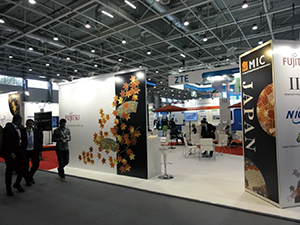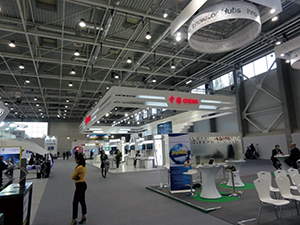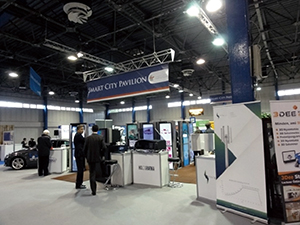 |
|
|
|
|
|
Global Standardization Activities Vol. 14, No. 4, pp. 62–64, Apr. 2016. https://doi.org/10.53829/ntr201604gls Report on ITU Telecom World 2015AbstractITU Telecom World 2015, which is sponsored by the International Telecommunication Union (ITU), was held at HUNGEXPO, an international exhibition hall, in Budapest, Hungary, October 12–15, 2015. Approximately 4000 people from 129 countries took part in the event. The Japanese presence included exhibits in the Japan Pavilion organized by the Ministry of Internal Affairs and Communications, and a Japan Session, in which a lecture was given on the topic Society Construction with a Sense of Security - Making Full Use of “IoT” for Future Progress. This article presents an overview of the exhibition and the lectures. Keywords: ITU Telecom World, IoT, SME 1. IntroductionITU Telecom World is a combined conference and exhibition that is held for International Telecommunication Union (ITU) member countries. It is aimed at sharing the latest technologies and services in the information and communications field and discussing policy trends in the information and communication technology (ICT) field. This event brings together people working in the information and communications industry, and also those working in the public administration of the industry worldwide. Until 2011, the event was held every four years. Since then, the event has been integrated with Telecom World, Telecom Asia, and other regional Telecom events and is now held annually. ITU Telecom World was held in Dubai, United Arab Emirates, in 2012, in Bangkok, Thailand, in 2013, and in Doha, Qatar, in 2014. The 2015 event was the first time in three years it was held in Europe. ITU Telecom World 2015 was held at HUNGEXPO in Budapest, the capital of Hungary, October 12–15, 2015. The main theme centered on assisting small- and medium-sized enterprises (SMEs) in emerging countries. There were SME-focused exhibits, and awards were presented to outstanding SMEs. Some 4000 persons from 129 countries took part in the event, including 239 prominent people in the public administration field or ICT industry, 247 lecturers from 62 countries, and 142 members of the press from 21 countries. There were 238 exhibits from 54 countries, 23 pavilions from 23 countries, and 49 sponsor enterprises. About 30 Japanese members attended the event, including Mr. Yasuo Sakamoto, Vice-Minister for Policy Coordination, Ministry of Internal Affairs and Communications. A report issued by ITU stated that representatives of regulatory and other administrative organizations made up 27% of all participants, while those from telecommunications operators totaled only 8%. Ten percent of the participants were from software and application developers, and only 5% were from the telecommunications equipment industry. In terms of regions, 60% of the participants were from Europe—the host region—and the CIS (Commonwealth of Independent States), 23% from Asia-Pacific, 8% from Africa, and 6% from the Middle East. 2. Overview of exhibition and lectures2.1 Opening ceremonyAn opening speech by Houlin Zhao, ITU Secretary-General, was followed by a video message from Ban Ki-moon, Secretary-General of the United Nations, a greeting from the vice president of Deutsche Telecom, and a welcome address from the Prime Minister of Hungary. 2.2 ExhibitionFour organizations (Fujitsu, National Institute of Information and Communications Technology, Internet Initiative Japan, and Japan Battery Regeneration, Inc.) participated in the Japan Pavilion (Photo 1), where they exhibited environmental solutions, data-oriented networking technology, Dagik Earth—an educational project and multi-layer image display system, a portable datacenter, and technology for regenerating and extending the life of lead-acid batteries.
The pavilion of Hungary, the host country, had an exhibit on Magyar Telekom, which is a subsidiary of Deutsche Telecom. The China Pavilion presented exhibits from China Mobile, China Telecom, and China Unicom (Photo 2). Korea Telecom (now, KT Corporation) had its own pavilion (Photo 3). A large percentage of the 23 country pavilions were from African nations such as Rwanda, Uganda, Gabon, Kenya, Zimbabwe, Tanzania, and Senegal. These pavilions introduced the respective countries’ ICT policies. Countries that had their own pavilions included Hungary, Saudi Arabia (Middle East), Argentina (South America), Azerbaijan (CIS), and Japan, Thailand, and South Korea (Asia).
Huawei, ZTE, and Intel were among the enterprises that had their own pavilions. In addition, some pavilions were dedicated to specific concepts such as Smart City and SME (Photo 4).
2.3 Lecture in the Japan SessionOn the afternoon of the 12th, a Japan Session was held under the theme of Society Construction with a Sense of Security - Making full use of “IoT” for Future Progress, sponsored by the Ministry of Internal Affairs and Communications. After Mr. Sakamoto of the Ministry greeted the audience and introduced the participating enterprises, lectures were given on behalf of those enterprises. One lecturer was Dr. Ryutaro Kawamura, Director of NTT Network Innovation Laboratories, who gave a talk entitled “IoT 2.0.” He spoke about the key technologies and their significance in realizing IoT 2.0, the next stage of Internet of Things, which is a revolution that is already underway, with everything in a variety of fields becoming interconnected via networking. There were several other sessions, including one on agriculture given by FAO (Food and Agriculture Organization of the United Nations), a session on medical care given by WHO (World Health Organization), and a session focusing on development of ICT engineers. 2.4 Topics related to SMEsSMEs were the focus of this event, and therefore, exhibits, SME presentations, and a dialog session with the industry were held with a view to building a platform for supporting the formation of SMEs. Awards were also conferred on SMEs, including the firm Japan Battery Regeneration, Inc., which is developing technology for regenerating lead-acid batteries. Additionally, outstanding SMEs were selected from among the award recipients and given commendations. They included two South Korean companies working on Braille and iris recognition, two Kenyan companies working in the respective areas of agriculture and medical care, and a Saudi Arabian company involved in medical care. In addition, three Hungarian companies received commendations, and a South Korean supplier of three-dimensional sound systems was selected as the most outstanding company. 3. Next eventThe organizers of ITU Telecom World 2015 tried out a new initiative of encouraging participation by SMEs. There were many participants from Africa, suggesting that emerging countries have high expectations of ITU. The next event, ITU Telecom World 2016, is scheduled to be held in Bangkok, Thailand in November 2016. |
|













